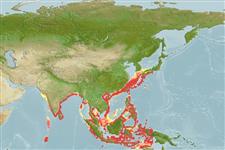>
Eupercaria/misc (Various families in series Eupercaria) >
Nemipteridae (Threadfin breams, Whiptail breams)
Etymology: Parascolopsis: Greek, para in the side of + Greek, skolos = stake + Greek, ops = appearance (Ref. 45335).
More on authors: Temminck & Schlegel.
Environment: milieu / climate zone / profondeur / distribution range
Écologie
marin démersal; non migrateur; profondeur 60 - 131 m (Ref. 9785). Tropical; 36°N - 12°S, 69°E - 136°E (Ref. 3810)
Eastern Indian Ocean: including the Laccadive Islands, Sri Lanka, Andaman Sea. Western Pacific: including southern Japan and the South China Sea.
Taille / Poids / Âge
Maturité: Lm ? range ? - ? cm
Max length : 18.0 cm SL mâle / non sexé; (Ref. 3810); common length : 12.0 cm SL mâle / non sexé; (Ref. 3810)
Épines dorsales (Total) : 10; Rayons mous dorsaux (Total) : 9; Épines anales: 3; Rayons mous anaux: 7. Head scales reaching forward to between middle of eye. Posterior margin of preopercle sloping forward slightly. Lower limb of preopercle naked. Posterior margin of suborbital fine serrate, with a very small spine at upper corner. Pectoral fins long, reaching to or beyond level of anus. Pelvic fins long, reaching to or almost to level of anus. Color: Pale yellowish body, silvery below.
Body shape (shape guide): fusiform / normal; Cross section: oval.
Inhabits sandy or muddy bottoms in offshore waters. Usually in small groups, in depths over 50 m (Ref. 48635). Feeds mainly on benthic invertebrates. Also caught with deep-sea shrimp traps.
Life cycle and mating behavior
Maturité | Reproduction | Frai | Œufs | Fécondité | Larves
Russell, B.C., 1990. FAO Species Catalogue. Vol. 12. Nemipterid fishes of the world. (Threadfin breams, whiptail breams, monocle breams, dwarf monocle breams, and coral breams). Family Nemipteridae. An annotated and illustrated catalogue of nemipterid species known to date. FAO Fish. Synop. 125(12):149p. Rome: FAO. (Ref. 3810)
Statut dans la liste rouge de l'IUCN (Ref. 130435: Version 2024-2)
Menace pour l'homme
Harmless
Utilisations par l'homme
Pêcheries: intérêt commercial mineur
Outils
Articles particuliers
Télécharger en XML
Sources Internet
Estimates based on models
Preferred temperature (Réf.
123201): 17.8 - 27.4, mean 24 °C (based on 251 cells).
Phylogenetic diversity index (Réf.
82804): PD
50 = 0.5001 [Uniqueness, from 0.5 = low to 2.0 = high].
Bayesian length-weight: a=0.01380 (0.00695 - 0.02741), b=2.96 (2.79 - 3.13), in cm total length, based on LWR estimates for this species & (Sub)family-body (Ref.
93245).
Niveau trophique (Réf.
69278): 3.5 ±0.44 se; based on food items.
Generation time: 1.6 ( na - na) years. Estimated as median ln(3)/K based on 1
growth studies.
Résilience (Réf.
120179): Haut, temps minimum de doublement de population inférieur à 15 mois (K=0.70).
Fishing Vulnerability (Ref.
59153): Low vulnerability (21 of 100).
🛈
